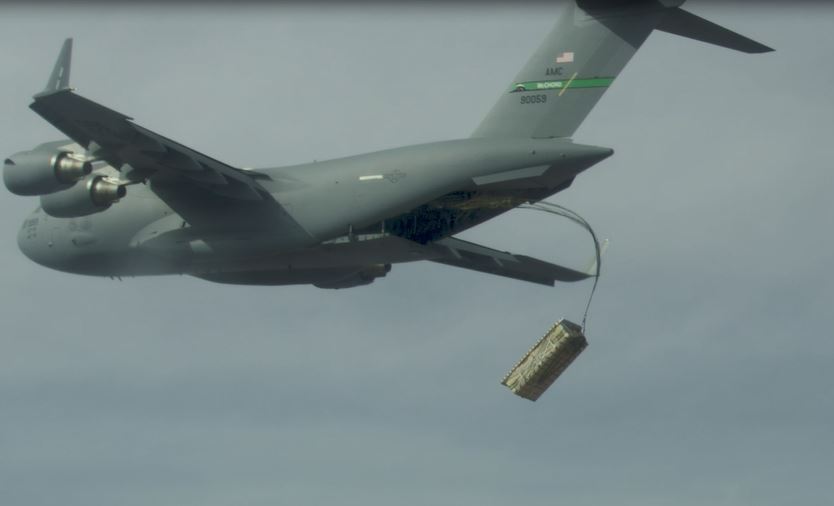

The Air Force is continuing to experiment with delivering munitions on pallets thrown from the back of cargo aircraft as a way to turn transports into munitions trucks that provide additional strike capacity during a potential future conflict.
During the latest test of the so-called ‘palletized munitions‘ system, airmen from the 412th Test Wing in coordination with Air Mobility Command recently conducted a drop of multiple AGM-158 Joint Air-to-Surface Standoff Missile cruise missiles from a C-17 Globemaster III, the Air Force Research Laboratory announced last week.
The test took place during a testing “on-ramp” for the Air Force’s Advanced Battle Management Family of Systems (ABMS) at Nellis Air Force Base in Nevada, the same demonstrations that saw the service test out robot dogs as backup for security forces and mobile laser weapons to protect convoys from enemy drones.

Previously referred to as “a bomb bay in a box” in a February request for information, the Air Force believes that “delivering standoff type weapons in mass, from non-traditional delivery platforms, is one potential option to deliver mass firepower and could prove pivotal in future conflicts,” according to the RFI.
This isn’t the first time the Air Force has opted to deliver munitions to a target via a customized pallet: In January, Air Force Special Operations Command successfully dropped simulated palletized munitions from a MC-130J Commando II multi-mission combat transport/special operations tanker in a test at Dugway Proving Ground in Utah.
During that experiment, which ARFL announced in May, the MC-130J’s aircrew deployed five wooden pallets known as Combat Expendable Platforms carrying six simulated munitions in three airdrops.
Related: The Air Force is experimenting with turning cargo planes into flying munitions trucks
Four of the six munitions on one pallet were simulated “Cargo Launch Expendable Air Vehicles with Extended Range (CLEAVERs),” which AFRL described as “long-range, high-precision weapons” able to “destroy moving and non-moving targets.”
The Air Force had also previously tested the palletized munitions concept with another C-17 military transport aircraft.
“This successful [demo] is evidence of our commitment to evolve innovative weapons concepts and enhance our partnership with AFSOC to meet the needs of the National Defense Strategy,” said Col. Garry Haase, the director of AFRL’s Munitions Directorate, in a statement at the time.
“CLEAVER represents a different approach to launching large numbers of long-range weapons, which will bring a new dynamic to the high-end fight.”

It’s unclear when the palletized munition concept may move from testing to prime time: despite its previous February RFI, the Air Force has not issued any contracts regarding the concept in the intervening months.
The palletized munitions capability “could enable various airlift aircraft to employ a range of weapons en masse via a self-contained, roll-on/roll-off palletized system, and may offer an alternative way for the Air Force to bring more mass to the fight,” said Dr. Dean Evans of the service’s Strategic Development Planning and Experimentation office in a statement.
“The successful demo represents a key step in SDPE’s Palletized Munitions Experimentation Campaign, which will determine if the Palletized Munitions concept is feasible and provides a competitive advantage for the warfighter.”
